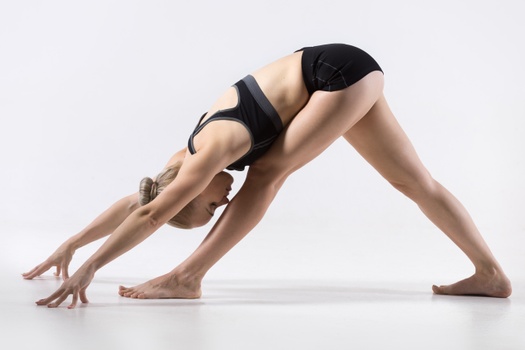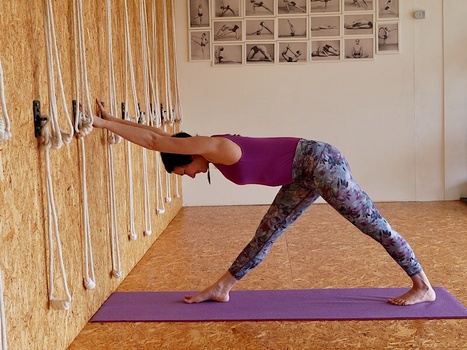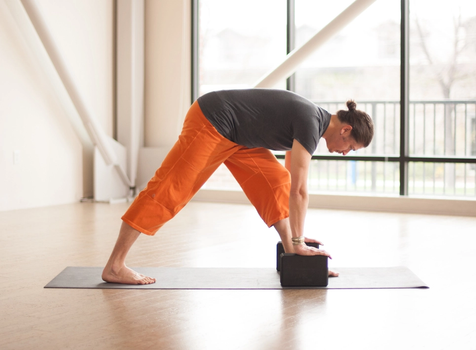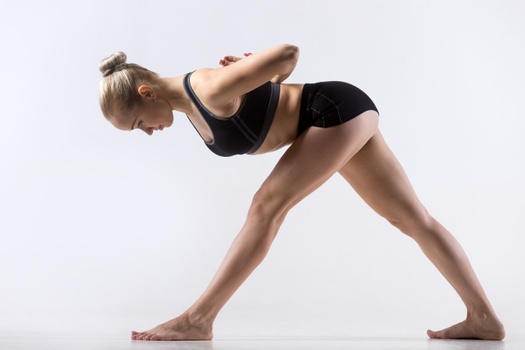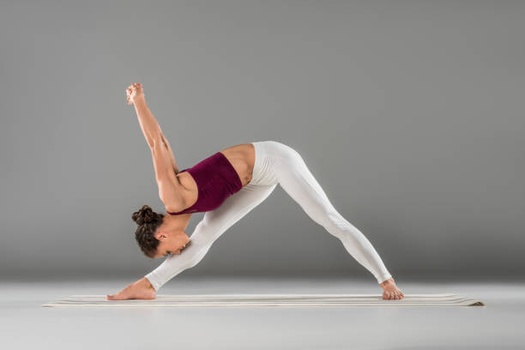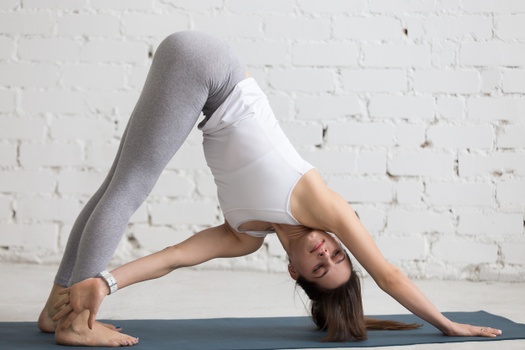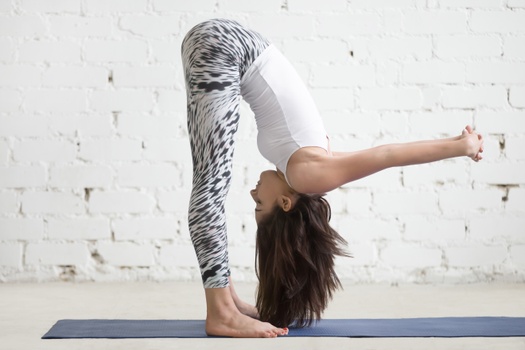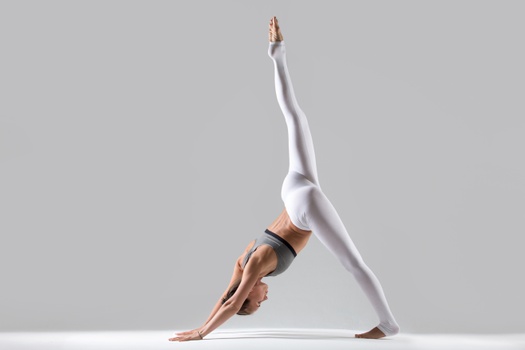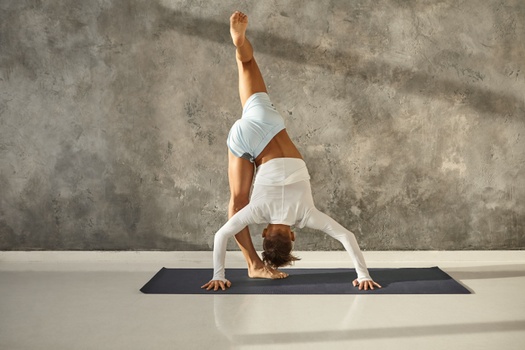The practice of Parshvottanasana, or pyramid pose, is divided into four main stages, warm-up, steps, posture cues, and relaxing pose.
Part 1 - Preparatory Poses for Parshvottanasana
It’s important to activate blood circulation in the spine, hamstrings, and lower back. Get started with these warm-up poses before you practice pyramid pose:
1. Tadasana (Mountain Pose) - It helps to build a strong foundation for all standing yoga poses. Start with standing in the center of the mat with your feet two inches apart. Keep your spine straight and gaze forward.
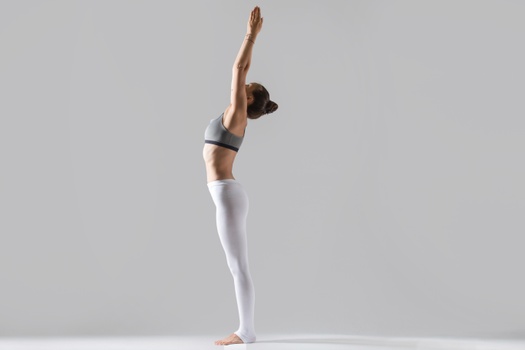
Take a deep breath, lift your arms to chest level and interlock your fingers. Inhale as you extend your arms overhead. Hold the pose here for a few seconds, then exhale and relax your limbs in a neutral standing position.
This pose is great for gently activating your legs, arms, shoulders, and spine.
2. Adho Mukha Svanasana (Downward-Facing Dog Pose) - From a table-top position, start to lift your glutes toward the ceiling, and keep your palms and feet pressed into the yoga mat. Maintain a tight core to stabilize in this position.
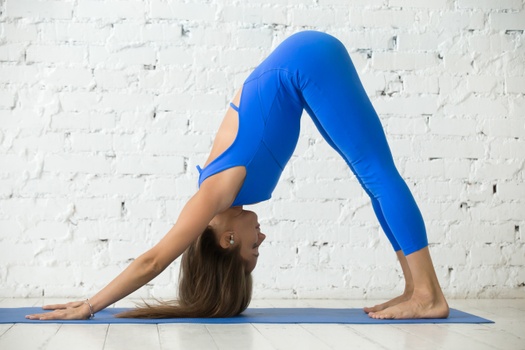
Hold the pose for 1-2 minutes and feel activation in your shoulders, back, hamstrings, and calves. This will help you develop core balance and introduce more mobility into the spine.
3. Prasarita Padottanasana (Intense Leg Stretch Pose) - Start by standing with your legs more than hip-width apart. Inhale and extend your arms over your head and exhale as you bend forward until your fingers can hold your big toes.
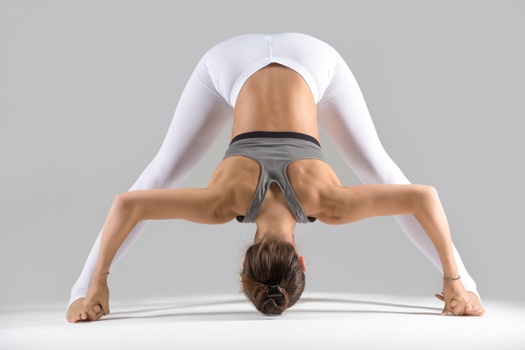
Hold this position for a few minutes. This wide stance forward fold is a great way to activate your inner legs, hamstrings, and lower back. It also encourages simultaneous rejuvenation of the neck, shoulders, and brain.
Part 2: Step-by-Step Instructions to Perform Parshvottanasana
The following are steps to practice an intense side stretch pose or Pyramid pose:
Step 1- Stand in the center of your mat and start with Mountain pose.
Step 2- Stand with a straight spine and hands in Anjali Mudra (Namaste). Focus on your breathing while closing your eyes.
Step 3- Step one foot halfway back on your mat and make a triangle with your legs.
Step 4- Keep both feet pointed in the same sideways direction. Extend both arms overhead and breathe in.
Step 5- Breathe as you reach downward and fold your upper body forward for Pyramid pose.
Step 6- Rest your fingertips on either side of your front foot.
Step 7- Keep the chest aligned with your front thigh and relax your neck by closing your eyes.
Step 8- As you hold the pose here, it’s good to maintain a soft bend in both knees.
Step 9- Finally, exit the pose by returning to Mountain pose, relax for a few seconds, and repeat the same on the other side.
Breath Awareness:
Inhale: While standing in Mountain pose as you extend both arms overhead.
Exhale: While folding the body forward into the side stretch.
Performance Duration for Beginners: Hold Parshvottanasana for 60 to 90 seconds on each side.
Performance Duration for Advanced: Hold Parshvottanasana for 2-5 minutes on each side.
Part 3: Things to Keep in Mind
To ensure your legs are safe, keep the following alignment tips in mind before you start your practice.
Check the distance between your legs: Positioning your legs too far apart or legs too close together can compromise the pose, making it unsafe and ineffective. Try to keep your legs slightly more than the hip-width apart.
Do not overstretch: Getting too low without enough leg muscle flexibility can overstretch your hamstrings. This can lead to a hamstring tear or low back pain. So, make sure to warm up your legs and back well before the main practice.
Don’t lock your knee joints: Locking the knee joint means keeping your legs too straight that it starts to hurt around the knees. This can severely cause wear and tear of knee joints and induce pain. Try to maintain a slight bend in the knees as you stretch onto your side.
Watch out for your hands: Do not place your palms on your shins as you execute the Parshvottanasana as this may lead to unnecessary pressure on your legs and hurt your knee joints.
Part 4: Relaxing Poses After Parshvottanasana
Here’s a list of a few counter-poses to perform after your intense side stretch pose practice:
1. Counter Spine Flexion: After intense side stretch, raise your upper body and arch your spine in the opposite direction while gazing toward the ceiling and placing your arms behind you in a reverse prayer pose.
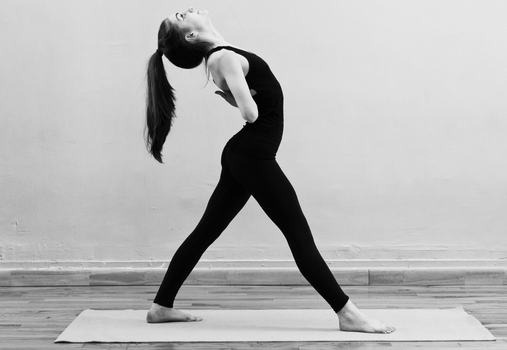
Hold this counter pose on each side for 30 to 90 seconds to bring your spine back to its natural shape.
2. Uttanasana (Standing Forward Bend): Straighten your spine by returning to Mountain pose. Now, breathe in and raise your arms overhead. Exhale as you start to fold forward, maintaining a slight bend in the knees, and completely resting your back, neck, and shoulders against your chest. Relax in this position for a few minutes.
